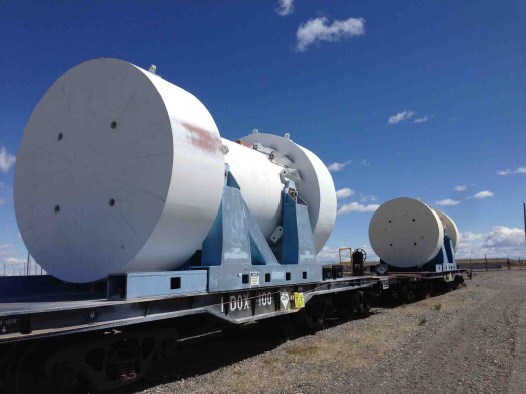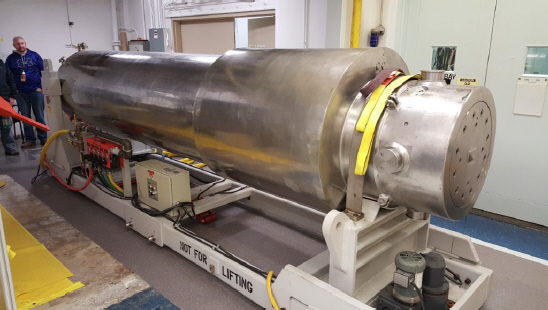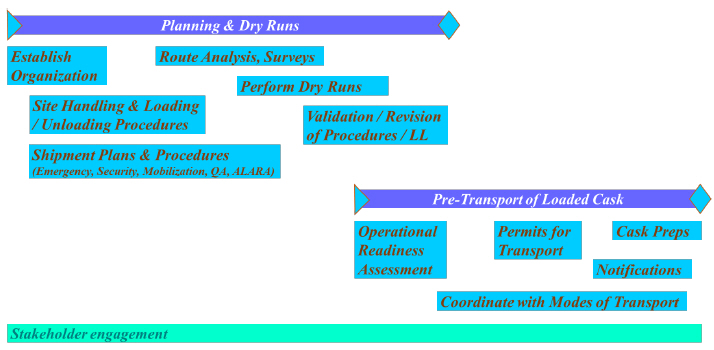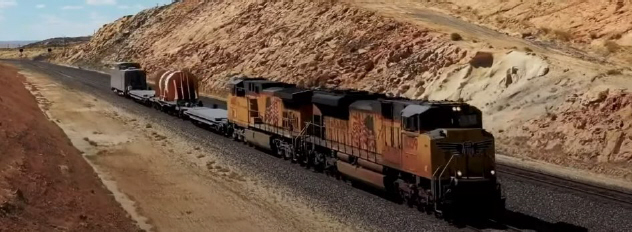Full-Scale Dry Run to Prepare for Shipment of High Burnup Used Nuclear Fuel
AUTHORS
John McEntire PMP
Donald McGee PMP
Sven Bader PhD
Orano Federal Services
PRESENTED
March 14, 2024
Waste Management Symposia
ABSTRACT
The nuclear industry requires processes involving the handling and transportation of UNF to be carefully planned and executed by qualified individuals. Oversight by experienced personnel is equally important to ensure all work is performed safely and to maintain public confidence. Therefore, a full-scale dry run is proposed to train and qualify the workers to minimize risk associated with preparing and transitioning a dual-purpose loaded storage cask into transportation mode, while also ensuring security is properly maintained during the transition. Work crews must gain experience performing physical activities such as heavy lift preparation and execution, down-ending a cask onto the transportation conveyance, upending/removal from the transportation conveyance, and installation and removal of impact limiters and personnel barriers. A dry run would provide the commercial nuclear industry with insights on transportation of UNF such as procedures development, incorporation of lessons learned, route analysis including rail inspections and upgrades, and stakeholder interactions (e.g., development of a communication strategy and outreach plan). It is also important to test and validate infrastructure at the loading point, any transloading location, the rail system, and the recipient point. Areas of improvement may also be identified regarding the role of the U.S. Nuclear Regulatory Commission (NRC) in transportation oversight, including evaluating existing regulations, guidance, and oversight readiness. Additionally, a dry run would validate that the loaded Demonstration Cask can be handled in a safe, compliant manner by the crews performing the work as well as providing regulators with experience overseeing a process to be performed for the first time by the commercial nuclear industry on this type of storage cask loaded with this quantity of HBU UNF.
INTRODUCTION
Safe shipment of UNF can be dated back as far as 1958 during the time of President Dwight D. Eisenhower’s Atoms for Peace Program when Argonne National Laboratory demonstrated its Argonaut reactor at the International Conference on the Peaceful
Uses of Atomic Energy in Geneva, Switzerland. The reactor was originally constructed at the Laboratory, then dismantled and transported to the conference where it was re-assembled and brought to criticality for demonstration purposes with used uranium
fuel from the world’s first nuclear energy reactor Chicago Pile-1, and then dismantled and safely shipped back to Argonne after conclusion of the Conference [1].
Figure 1, below, shows an excerpt from video footage recorded at the conference with Argonne National Laboratory personnel assembling the graphite block layers for the reactor.

Figure 1. Argonaut Reactor Assembly in Geneva, Switzerland, 1958 – Public Domain.
Since then, reactor operators of commercial power and research (from both foreign and university), military, and national laboratories have packaged and transported small quantities of UNF from sites on every continent including Antarctica. One of the largest U.S. shipments of UNF occurred in 2003 from West Valley Demonstration Project in New York to the Idaho National Laboratory with two Type-B packages containing a total of 125 UNF assemblies owned by the DOE [2]. It may be considered as the first real test of the United States infrastructure to license and ship a large quantity of commercial UNF. It resulted in several lessons learned from preparations that went into the shipment to regulatory frameworks, including insights into the areas of efficiency, quality, and cost control.
Figure 2. West Valley Demonstration Project Loaded Transport Casks Shipped to Idaho National Laboratory – Public Domain.
Within the current decade, and roughly 25 years following the West Valley shipping campaign, the DOE will once again be looking into another large shipment of UNF for the HBU Fuel Cask Demonstration Project. The Project has already licensed and loaded a TN-32B vertical dry storage cask (the “Demonstration Cask”) that was modified to allow for seven penetrations through the bolted lid for insertion of sixty-three thermocouples interspersed throughout the basket so that thermal measurements may be taken during the initial cask drying and long-term storage phase for research purposes. A transportation license application is in review with the NRC to allow for a one-time, exclusive-use shipment of the Demonstration Cask. This will be the first dual-purpose package licensed for both storage and transportation to be shipped from an operating commercial reactor site in the U.S., and the first to ship a high quantity of all HBU UNF. The project has high visibility due to its importance with ongoing examinations and testing to ensure safe, long-term licensed dry storage of HBU UNF.
The Project previously shipped a small number of fuel pins extracted from donor fuel assemblies stored in Dominion Energy’s North Anna Power Station used fuel pool using a legal weight truck cask to the Oak Ridge National Laboratory in 2016 (refer to Figure 3, next page). From there, some of the fuel pins were shipped to Pacific Northwest National Laboratory and Argonne National Laboratory for additional examinations. Those twenty-five fuel pins serve as the basis for a suite of confirmatory fuel examinations and testing that will be re-performed for comparison to the HBU UNF loaded in the Demonstration Cask following the approximate 10-year storage period and transportation. These activities will inform the industry on any changes in the properties and the behavior of HBU UNF under long-term dry storage conditions for insight into future disposal options [3].

Figure 3. Legal Weight Truck Cask Loaded with Donor Fuel Pins from North Anna Power Station at Oak Ridge National Laboratory – Public Domain.
To strengthen confidence in the industry and the public that the Project Team, consisting of Electric Power Research Institute Inc., Orano, and Dominion Energy can deliver the Demonstration Cask safely without incident, it is recommended that a full-scale dry run be conducted before the actual shipment occurs which will also aide in training, procedures validation, route approvals including rail system inspections and upgrades where necessary, and improve stakeholder interactions. A dry run will also help assure continuity of operations at the loading site and help to identify and implement lessons learned and improve regulatory oversight of the shipment. Finally, it may aide the DOE’s plans for transporting UNF currently stored at shutdown nuclear sites around the U.S. to a planned consolidated interim storage facility or national repository and inform on possible future shipments of UNF from operating nuclear sites.
Figure 4 illustrates some key tasks to be conducted by the Project Team during the planning and pre-transport activities. Of particular note, stakeholder engagement is an important role that should cross both phases of work.

Figure 4. HBU Dry Storage Cask Research and Development Project Proposed Planning and Pre-Transport Tasks.
There is a lack of and an ever-decreasing level of institutional knowledge within the industry to ship UNF. Licensees and vendors also lack recent direct experience to leverage. Therefore, it will be important for the Project Team to be properly staffed and utilize all relevant industry guidance and expertise during the planning and execution phases. A full-scale dry run activity is considered by the Project Team to be a critical evolution necessary for the successful shipment of UNF from an operational nuclear facility. This dry run is intended to be a physical, hands-on approach to training and qualifying the work crews for heavy lifts involving cask handling and shipping equipment handling, including the transportation skid, down-ending tools, impact limiters, and personnel barriers.
See Figure 5 below for a representation of the Demonstration Cask oriented for transportation on the transport skid with impact limiters, end stops, and personnel barrier (partially removed for clarity).

Figure 5. Demonstration Cask in Transport Configuration – Courtesy, Orano.
Cask handling onsite is a typical evolution for most operating sites; however, for the vertically oriented Demonstration Cask and other dual-purpose casks like it, there is little to no experience with positioning a loaded vertical cask into a horizontal transportation skid and likewise for the receiving site to remove the cask from its conveyance. Working with an unloaded cask in a dry run scenario will minimize handling risks and help develop efficiencies to achieve ALARA goals and identify areas of improvement for the site safety and security plans. A full-scale dry run will help test and validate infrastructure at the loading and offloading points and all locations in between including any transloading locations, heavy haul truck routes, and the railway systems.
The Project Team plans to perform full-scale dry run activities at key handling points using all the transportation equipment expected to be used for the actual shipment, including a like-for-like, unloaded cask that is identical to the Demonstration Cask with exception to its modified bolted lid that allows for thermocouples to be inserted through the lid for thermal data collection. Impact limiter bracket bars will be welded onto the unloaded cask’s outer shell in advance of the dry runs to match the Demonstration Cask to support installation of the impact limiters. The ATLAS and FORTIS railcars are expected to be ready for use and one of these railcars is intended to be used for the full-scale dry runs and available for the Demonstration Cask’s shipment. Since the impact limiters are the longest lead procured component of the transportation package, it is recommended that a dummy set of impact limiters be available for use while transporting the unloaded cask during transit evolutions to avoid possible damage to the actual impact limiters. The mock impact limiters should mimic the actuals to the greatest extent practical to verify clearances, alignments, and handling techniques.
It is intended to make the entire consist (that is, the locomotives, buffer cars, cask railcar, and escort car represented in Figure 6 below) available for public interactions and outreach at several points of interest across the U.S. to strengthen public perception and confidence through information campaigns. This will assist organizations such as the Nuclear Energy Institute to develop communication strategies and outreach plans for use with future UNF shipment campaigns. Detailed communication plans will be developed by the Project Team for stakeholder engagement and determination of the level of involvement. Interactions with the consist by stakeholders, including the NRC, will be encouraged. Some areas of improvement to regulatory oversight roles were identified by the NRC working group assembled in 2021 to assess regulatory readiness for oversight of commercial UNF transportation [5]. Full-scale dry run activities may address some of the identified improvement areas by providing regulatory inspectors with enhanced, practical training performing transportation safety and security inspections of shipments when they are being prepared and received and may encourage the update and consolidation of applicable inspection procedures for greater efficiency.

Figure 6. Representative Consist for Shipment of UNF – Public Domain.
Figure 1, below, shows an excerpt from video footage recorded at the conference with Argonne National Laboratory personnel assembling the graphite block layers for the reactor.

Figure 1. Argonaut Reactor Assembly in Geneva, Switzerland, 1958 – Public Domain.
Since then, reactor operators of commercial power and research (from both foreign and university), military, and national laboratories have packaged and transported small quantities of UNF from sites on every continent including Antarctica. One of the largest U.S. shipments of UNF occurred in 2003 from West Valley Demonstration Project in New York to the Idaho National Laboratory with two Type-B packages containing a total of 125 UNF assemblies owned by the DOE [2]. It may be considered as the first real test of the United States infrastructure to license and ship a large quantity of commercial UNF. It resulted in several lessons learned from preparations that went into the shipment to regulatory frameworks, including insights into the areas of efficiency, quality, and cost control.
Figure 2 shows both packages delivered onsite at Idaho National Laboratory.

Figure 2. West Valley Demonstration Project Loaded Transport Casks Shipped to Idaho National Laboratory – Public Domain.
Within the current decade, and roughly 25 years following the West Valley shipping campaign, the DOE will once again be looking into another large shipment of UNF for the HBU Fuel Cask Demonstration Project. The Project has already licensed and loaded a TN-32B vertical dry storage cask (the “Demonstration Cask”) that was modified to allow for seven penetrations through the bolted lid for insertion of sixty-three thermocouples interspersed throughout the basket so that thermal measurements may be taken during the initial cask drying and long-term storage phase for research purposes. A transportation license application is in review with the NRC to allow for a one-time, exclusive-use shipment of the Demonstration Cask. This will be the first dual-purpose package licensed for both storage and transportation to be shipped from an operating commercial reactor site in the U.S., and the first to ship a high quantity of all HBU UNF. The project has high visibility due to its importance with ongoing examinations and testing to ensure safe, long-term licensed dry storage of HBU UNF.
The Project previously shipped a small number of fuel pins extracted from donor fuel assemblies stored in Dominion Energy’s North Anna Power Station used fuel pool using a legal weight truck cask to the Oak Ridge National Laboratory in 2016 (refer to Figure 3, next page). From there, some of the fuel pins were shipped to Pacific Northwest National Laboratory and Argonne National Laboratory for additional examinations. Those twenty-five fuel pins serve as the basis for a suite of confirmatory fuel examinations and testing that will be re-performed for comparison to the HBU UNF loaded in the Demonstration Cask following the approximate 10-year storage period and transportation. These activities will inform the industry on any changes in the properties and the behavior of HBU UNF under long-term dry storage conditions for insight into future disposal options [3].

Figure 3. Legal Weight Truck Cask Loaded with Donor Fuel Pins from North Anna Power Station at Oak Ridge National Laboratory – Public Domain.
To strengthen confidence in the industry and the public that the Project Team, consisting of Electric Power Research Institute Inc., Orano, and Dominion Energy can deliver the Demonstration Cask safely without incident, it is recommended that a full-scale dry run be conducted before the actual shipment occurs which will also aide in training, procedures validation, route approvals including rail system inspections and upgrades where necessary, and improve stakeholder interactions. A dry run will also help assure continuity of operations at the loading site and help to identify and implement lessons learned and improve regulatory oversight of the shipment. Finally, it may aide the DOE’s plans for transporting UNF currently stored at shutdown nuclear sites around the U.S. to a planned consolidated interim storage facility or national repository and inform on possible future shipments of UNF from operating nuclear sites.
DISCUSSION
Planning the shipment of the Demonstration Cask will be a challenging and complex endeavor that will take several years of preparation. The Nuclear Energy Institute recommends a minimum of five years for planning prior to the expected shipment date and at least 6 months in advance of the shipment to submit the application for route approval by the NRC [4]. As identified from lessons learned on the West Valley shipment, nearly two years were needed to negotiate contracts with rail carriers [2]. More than 2,000 miles of railway track may need to be inspected depending on the destination and selected routes. Procurement of shipping equipment, onsite/offsite infrastructure evaluations and preparations, training, and procedures development, etc. are all time-consuming, long-lead activities that will need to be planned and scheduled well in advance of the expected shipment date.Figure 4 illustrates some key tasks to be conducted by the Project Team during the planning and pre-transport activities. Of particular note, stakeholder engagement is an important role that should cross both phases of work.

Figure 4. HBU Dry Storage Cask Research and Development Project Proposed Planning and Pre-Transport Tasks.
There is a lack of and an ever-decreasing level of institutional knowledge within the industry to ship UNF. Licensees and vendors also lack recent direct experience to leverage. Therefore, it will be important for the Project Team to be properly staffed and utilize all relevant industry guidance and expertise during the planning and execution phases. A full-scale dry run activity is considered by the Project Team to be a critical evolution necessary for the successful shipment of UNF from an operational nuclear facility. This dry run is intended to be a physical, hands-on approach to training and qualifying the work crews for heavy lifts involving cask handling and shipping equipment handling, including the transportation skid, down-ending tools, impact limiters, and personnel barriers.
See Figure 5 below for a representation of the Demonstration Cask oriented for transportation on the transport skid with impact limiters, end stops, and personnel barrier (partially removed for clarity).

Figure 5. Demonstration Cask in Transport Configuration – Courtesy, Orano.
Cask handling onsite is a typical evolution for most operating sites; however, for the vertically oriented Demonstration Cask and other dual-purpose casks like it, there is little to no experience with positioning a loaded vertical cask into a horizontal transportation skid and likewise for the receiving site to remove the cask from its conveyance. Working with an unloaded cask in a dry run scenario will minimize handling risks and help develop efficiencies to achieve ALARA goals and identify areas of improvement for the site safety and security plans. A full-scale dry run will help test and validate infrastructure at the loading and offloading points and all locations in between including any transloading locations, heavy haul truck routes, and the railway systems.
The Project Team plans to perform full-scale dry run activities at key handling points using all the transportation equipment expected to be used for the actual shipment, including a like-for-like, unloaded cask that is identical to the Demonstration Cask with exception to its modified bolted lid that allows for thermocouples to be inserted through the lid for thermal data collection. Impact limiter bracket bars will be welded onto the unloaded cask’s outer shell in advance of the dry runs to match the Demonstration Cask to support installation of the impact limiters. The ATLAS and FORTIS railcars are expected to be ready for use and one of these railcars is intended to be used for the full-scale dry runs and available for the Demonstration Cask’s shipment. Since the impact limiters are the longest lead procured component of the transportation package, it is recommended that a dummy set of impact limiters be available for use while transporting the unloaded cask during transit evolutions to avoid possible damage to the actual impact limiters. The mock impact limiters should mimic the actuals to the greatest extent practical to verify clearances, alignments, and handling techniques.
It is intended to make the entire consist (that is, the locomotives, buffer cars, cask railcar, and escort car represented in Figure 6 below) available for public interactions and outreach at several points of interest across the U.S. to strengthen public perception and confidence through information campaigns. This will assist organizations such as the Nuclear Energy Institute to develop communication strategies and outreach plans for use with future UNF shipment campaigns. Detailed communication plans will be developed by the Project Team for stakeholder engagement and determination of the level of involvement. Interactions with the consist by stakeholders, including the NRC, will be encouraged. Some areas of improvement to regulatory oversight roles were identified by the NRC working group assembled in 2021 to assess regulatory readiness for oversight of commercial UNF transportation [5]. Full-scale dry run activities may address some of the identified improvement areas by providing regulatory inspectors with enhanced, practical training performing transportation safety and security inspections of shipments when they are being prepared and received and may encourage the update and consolidation of applicable inspection procedures for greater efficiency.

Figure 6. Representative Consist for Shipment of UNF – Public Domain.
CONCLUSION
By facilitating a full-scale dry run, the industry will increase the likelihood of a successful outcome by preparing and training the work crews to handle a loaded UNF cask and eliminating unforeseen challenges during the shipment. In addition, a dry run will enable regulators overseeing the process to become equally familiar with the planned logistics and methods to ensure compliance. Early identification of lessons learned and issues from the industry through advanced planning will facilitate corrective action and mitigation to ensure the actual shipment is transported in a safe and compliant manner. Early stakeholder inclusion will assure constructive communications with federal, state, local, and tribal organizations throughout the planning process.REFERENCES
- Nuclear Engineering Division, “Reactors Designed by Argonne National Laboratory, Training Reactors, Argonaut.” [Online] Available: https://www.ne.anl.gov/About/reactors/training.shtml.
[Accessed November 12, 2023].
- M. Tyacke and T. Anderson, “Lessons Learned from the West Valley Spent Nuclear Fuel Shipment within the United States,” presented at the 14th International Symposium on the Packaging and Transportation of Radioactive Materials Conference,
Berlin, Germany, September 20-24, 2004, Paper No. 212.
- J. McEntire, “Versatile Transportation Skid Option for the TN-32B Demonstration Cask,” presented at the 20th International Symposium on the Packaging and Transportation of Radioactive Materials, Juan-Les-Pins, France, June 11-15, 2023,
Paper No. 206.
- Nuclear Energy Institute, “Spent Fuel Transportation Planning and Implementation,” NEI 20-02, Revision 0, December 2021.
- U.S. Nuclear Regulatory Commission, “NRC’s Regulatory Readiness for Oversight of Large-Scale Commercial Transportation of Spent Nuclear Fuel,” ML21298A164, October 2021.
ACKNOWLEDGEMENTS
Orano Federal Services wishes to thank the Electric Power Research Institute and the DOE in partnering with Orano for continuing its efforts identifying solutions for the future transportation of UNF from commercial reactor sites across the United States. We also wish to thank Dominion Energy for their continued support of our project by hosting the Demonstration Cask at their North Anna Power Station since 2017 and working with us through planning for the first-ever shipment of a loaded dual-purpose cask from an operating nuclear energy station.>> Return to Orano White Papers
